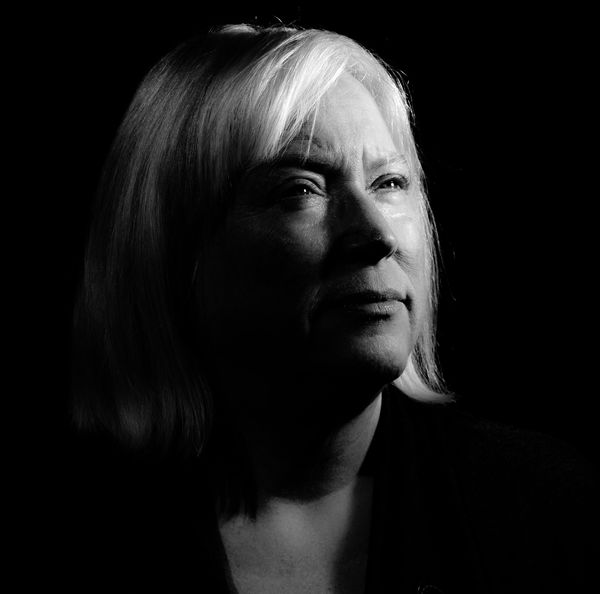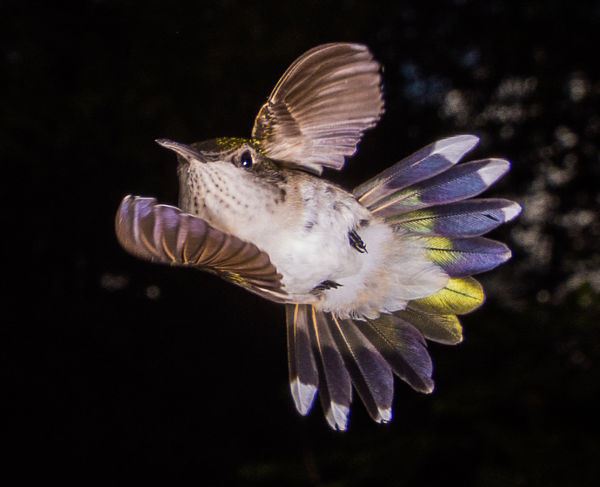High Speed Sync
Nov 21, 2017 06:28:23 #
Silverman wrote:
I have a Nikon D3300, please explain "High Speed Sync", what ir is, and what purpose does it fulfill in my Photography. I am a beginner of about One year.
HSS allows greater flexibility for using light during fast shutter speeds, regardless of ambient lighting or for portraiture outdoors. These two images were shot using HSS, one at 1/6400 to create the dark background and the other at 1/8000 to freeze motion. Because the flash is actually sending out hundreds of pulses during the exposure to ensure the entire sensor receives light, the power is significantly reduced and the subject to flash distance has to be very small (inches in the case of the hummingbird).
Nov 21, 2017 09:00:40 #
Silverman wrote:
I have a Nikon D3300, please explain "High Speed Sync", what ir is, and what purpose does it fulfill in my Photography. I am a beginner of about One year.
In order to understand what HSS is (regardless that your particular camera apparently does not offer it), you need to understand how your camera's shutter works in the first place.
The "focal plane" shutter used in the vast majority of DSLRs incorporates two "curtains". Imagine the camera's shutter system as a movie theater (well, from the old days) where the curtains were pulled aside to expose the movie screen. Except, with a focal plane shutter, one curtain is pulled all the way across the "screen" (imagine chip) and the other is collapsed fully on the side. When you press the shutter button, the curtain covering the chip swiftly moves aside to expose the "screen", and at some point (depending on the shutter speed you select) the second curtain is drawn over the screen to cover it again. So, for a shutter speed of, say 1 second, the first curtain opens (and they move very quickly) and just about one second later the second curtain moves to cover the sensor.
The curtains themselves move fast enough that even at relatively short exposures (like 1/250th of a second) there is an instant where the entire imaging chip is exposed simultaneously; the flash is triggered at that instant in order to expose the full picture. However, at quicker shutter speeds, the second curtain has to start closing the space before the first curtain has made it all the way to the other side, meaning that there is no one instant in time where the complete chip is opened to exposure and if the flash is triggered it will not illuminate the entire scene. In effect, the higher the shutter speed being used, the narrower the "slit" is that moves across the imaging chip.
HSS is a kind of workaround to this issue - the flash (again, you need a flash that can do it) is actually triggered multiple times during the exposure so that each "slit" that is exposed gets a helping of light. Of course, when you shoot at those kinds of high shutter speeds, your eye cannot even tell, but that's what is going on electro-mechanically.
Nov 21, 2017 09:49:15 #
gvarner
Loc: Central Oregon Coast
rwilson1942 wrote:
High speed sync is a flash mode that allows the use of shutter speeds above the normal maximum flash sync shutter speed (1/250 second on my camera).
Don't know the D3300 but with my flash and camera High speed sync will allow shutter speeds of up to 1/8000 s.
I believe the main purpose is to allow blending of natural light and flash.
Don't know the D3300 but with my flash and camera High speed sync will allow shutter speeds of up to 1/8000 s.
I believe the main purpose is to allow blending of natural light and flash.
Correct, controlling ambient light is the benefit. Easy to do with a TTL flash. Set flash on TTL mode, camera in Manual mode, F4, ISO 400 for starters. The TTL feature will let the flash shut off when proper exposure is reached on the subject. Outdoors a very high shutter speed like 1/800 or even into the 1/1000's will darken bright ambient light. Indoors a shutter speed of 1/200 or more will negate the effect of indoor lighting, set a higher speed and reduce the bright light coming through the windows. Subject still gets properly exposed. You can change the F stop to affect the DoF or the ISO to give the flash a little more reach. The TTL will respond accordingly.
Nov 21, 2017 10:00:43 #
ricosha
Loc: Phoenix, Arizona
BebuLamar wrote:
Cameras with the focal plane shutter that is the s... (show quote)
One of the best explanations of a question (answered) response I've seen on this forum...



Nov 21, 2017 10:06:43 #
peterg
Loc: Santa Rosa, CA
f8lee wrote:
HSS is a kind of workaround to this issue - the flash (again, you need a flash that can do it) is actually triggered multiple times during the exposure so that each "slit" that is exposed gets a helping of light. Of course, when you shoot at those kinds of high shutter speeds, your eye cannot even tell, but that's what is going on electro-mechanically.
HSS is a kind of workaround to this issue - the flash (again, you need a flash that can do it) is actually triggered multiple times during the exposure so that each "slit" that is exposed gets a helping of light. Of course, when you shoot at those kinds of high shutter speeds, your eye cannot even tell, but that's what is going on electro-mechanically.
 The flash divides it's full/partial power to many lower intensity pulses.
The flash divides it's full/partial power to many lower intensity pulses.See: http://fstoppers.com/originals/demystifying-high-speed-sync-68527
Nov 21, 2017 16:44:21 #
Silverman wrote:
I have a Nikon D3300, please explain "High Speed Sync", what ir is, and what purpose does it fulfill in my Photography. I am a beginner of about One year.
I don't think the D3300 has high speed sync capability.
Nov 21, 2017 23:57:26 #
Learn and get entertained at the same time! With Andrew Boey. (He's a Nikon user but that doesn't really matter in many cases.)
https://www.youtube.com/watch?v=MUwfwFYl2MY
https://www.youtube.com/watch?v=NcJUYw5iDXs
https://www.youtube.com/watch?v=JflxDO_AvME
https://www.youtube.com/watch?v=MUwfwFYl2MY
https://www.youtube.com/watch?v=NcJUYw5iDXs
https://www.youtube.com/watch?v=JflxDO_AvME
If you want to reply, then register here. Registration is free and your account is created instantly, so you can post right away.





